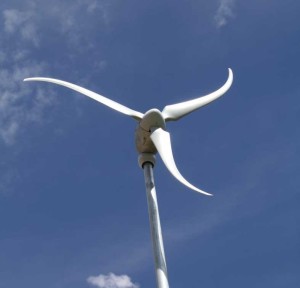Board of supervisors gathering info, get presentation on residential wind turbines
By Mike McGann, Editor, UnionvilleTimes.com

The East Marlborough Board of Supervisors is taking the first steps toward crafting an ordinance that would give township property owners options when it comes to installing "green" energy generation systems, such as this wind turbine manufacturered and sold by South West Wind Power.
EAST MARLBOROUGH — The future is coming and township officials say the time has come to plan for it.
While generally true for most subjects, supervisors put their focus Monday night on the process of creating an ordinance to allow for residential green energy generation. While solar collectors are currently allowed on residential rooftops, there are no provisions for ground installations of solar, wind turbines or geo-thermal installations.
As of right now, none can be installed without a zoning variance, a barrier to residents adopting clean energy options.
“Our process is to come up with an ordinance for various green energy applications,” Board of Supervisors chair Cuyler Walker said. Walker said that the ordinance will have to go through the normal process, including a public hearing, so that a wide-range of public input and information can be incorporated. Part of that process is learning the specific needs and requirements of various “green” energy generation options.
As part of a process that is expected to last a minimum of six months, supervisors are gathering information and criteria on which to base the new ordinance. During Monday night’s Board of Supervisors’ meeting, representatives of South West Wind Power (SWWP), a Flagstaff, Ariz.-based company made a presentation about their experience with residential wind turbine installations.
Scott Brown, president and chief operating officer of SWWP, and a township resident — who noted he would like to be able to build a turbine on his property on the northwest side of the township — ran through the particulars of how typical residential installs work.
SWWP has been building and installing wind turbines since 1987 — some 170,000 units in 88 countries, including about 8,000 in the U.S. — but their use in residential areas is a somewhat new wrinkle. These new turbines are a very different device from the traditional farm-style windmills that dotted the Unionville area for generations as part of local farms. Being much smaller, they’re also nothing like the giant wind turbines used for wind farms — these units are much smaller and less intrusive.
Typically, they’re built on tapering monopoles — akin to streetlight poles — typically 45 feet tall, although some installs are done on 33-foot poles. Turbines cannot be installed safely on rooftops — unless the building is specifically designed for it, Brown said.
According to Jay Yaeger, a turbine installer, who joined Brown in the presentation, locating the towers is based on computer models — site surveys would often cost nearly as much as the estimated $15,000 to $16,000 cost to install a turbine — not including a 30% federal tax credit most home owners would be eligible to get.
Like solar installations, most residential turbines push power back onto the local power grid when homeowners generate more power than needed, which in essence makes their power meters go backward. The system isn’t intended to replace local power — although there are larger applications for complete power independence, typically used in more remote and windier areas.
Brown estimated that the return on investment for the typical home owner would be in the range of 6 ½ to 7% over the 20-year anticipated life of the turbine.
“It’s not a super payback, but a steady one,” Brown said, noting that such an install also has a positive impact on home values. He noted that location and install options have a major impact on whether it makes sense for a homeowner to look at an install — SWWP has a special web site for consumers to get a quick snapshot on whether an install makes financial sense on their property.
Although Yeager notes that while installs have been done in typical subdivisions on lots as small as ½ acre, topography and wind profiles vary, so it might not be a good option for everyone.
A quick check on SWWP’s evaluation site of a home in a neighboring township shows only the potential to generate about 8% of that household’s energy — worth about $750 annually — whereas homes just a few miles away are able to generate much more power. And even the lower performing home — taking into account the tax credits — would probably still end up being a marginally profitable install for the homeowner, depending on financing costs. And that doesn’t take into account the environmental benefit.
Still, supervisors asked questions about safety — and the one issue that seems create opposition to wind turbines: noise.
Yaeger said that the units generate noise somewhat less than window air conditioner units — and actually sound less noisy when the wind picks up, because the wind created additional ambient noise. He said the maximum added noise amounts to about 10 dB, falling to a differential as low as 5 dB when windy.
On safety, he noted that the units automatically are held to a maximum speed magnetically and stop entirely during extreme wind conditions, both for safety and to preserve the mechanical integrity of the turbine unit.
The board of supervisors are expected to continue gathering information on alternative energy installations before offering a comprehensive proposed ordinance either later this year or early in 2012.






